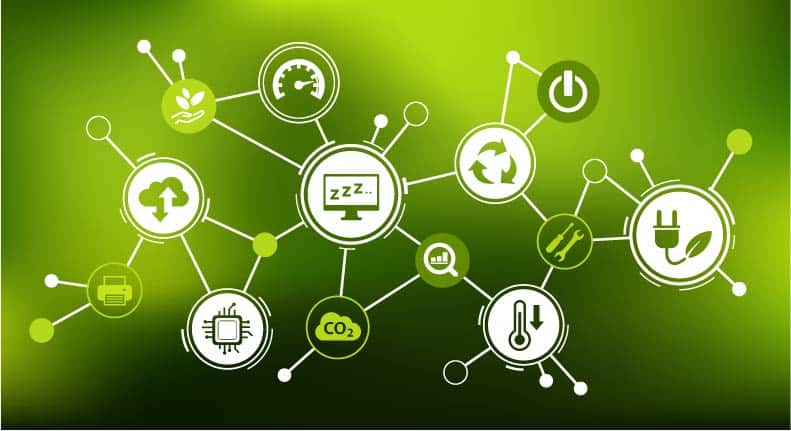Improve Your Green Initiatives and Reduce Your Carbon Footprint
Connectria
Author
Date
March 17, 2020

As more and more companies actively seek to reduce their overall environmental impacts, one often overlooked discussion is the positive impact of cloud computing. As more providers invest in massive and impactful green initiatives, moving to the cloud may be the greenest decision you can make.
Cloud centers are simply better positioned to manage workloads, maximize the physical footprint per user, and isolate energy sources to renewables like solar and wind. Today: all of Apple’s data centers are powered by renewables, something that was unthinkable even a decade ago.
Economical and Environmental
Massive data centers have the aggregate manpower and strategic capacity to plan for a carbon-neutral future in ways that individual companies, with smaller server builds, simply cannot. Commercial data center operators can proactively build or upgrade buildings to maximize airflow, plan for onsite or nearby renewable energy sources, and use far less energy per square foot than most private companies can by managing servers locally.
Years ago, most cloud providers started making proactive upgrades to reduce energy workloads and increase margins. While business requirements are obviously a huge driver for this, financial and other market pressures on tech have pushed large and small cloud providers to minimize energy use and maximize efficiency. No matter what other internal steps you take, maintaining on-site servers is far less efficient than using data centers. Shifting more and more of your data operations to the cloud is economical and relatively easy to do. It’s also an excellent way to satisfy your company’s aggressive green initiatives and environmental goals.
Cloud Data Centers Make More Efficient Use of Physical Resources
Energy efficiency is about more than reducing what you use. It’s also about creating resources that serve more and more users from a single location. There’s a logical line to draw here between owning your own car or using public transportation. Like a bus or a train, a cloud center services several customers at once. Like public transport, the cloud has a far better ratio of users-to-resources than an on-site server room.
Data centers also maximize utilization for physical hardware (around the range of 98%). Taking the transportation analogy a step further, this is akin carpooling. One car with one person (or one workload) is completely wasteful while packing that car full of passengers increases the utilization for that individual car.
A traditional enterprise data center operates at a utilization rate of, at best, roughly 10%. Just like a fuel-guzzling limousine is one of the least efficient cars for a daily commute, migrating to the public cloud uses much less power because you’re sharing resources with other clients.
Big data companies are in a position to make huge changes with one major decision. As an individual company, you have no choice but to purchase energy from a local utility. However, data centers utilize enough power to buy wholesale energy from alternative sources. Microsoft, for example, made a goal to purchase an impressive 60% of the electricity used in its data centers from renewable sources by 2020.
Cloud Computing Means Making Less Physical “Stuff”
Let’s talk about peak loads for a moment. When you source your own hardware, you must plan for peak loads. How often do you actually use that equipment at peak capacity? A cloud center balances out workloads between different clients, reducing the need to overbuild capacity because it might be needed.
Frequent purchases of new equipment can increase your company’s carbon footprint and eventual waste. Though newer equipment might be more efficient and reduce power consumption, this has to be balanced against the carbon cost of manufacturing new equipment, and the impact of disposing of the old. A large data center has an advantage here, as it can negotiate recycling agreements that individual businesses simply can’t due to volume.
New equipment means not just more manufacturing, but also more trucks on the road and more ships on the sea. There is almost nothing less efficient than small individual shipments and small orders. When a data center upgrades equipment, it does so strategically, which cuts down on smaller shipments to individuals.
Cloud Computing Enables Remote Work
The old model of expansion was that in order to hire more people, you had to expand your physical footprint. Because data centers maximize utilization and loads, cloud computing enables the same access to each user–no matter where they are.
Professionals working from home, regardless of where they call “home”, also have access to faster internet speeds than ever. Cloud computing makes it feasible to increase the number of employees without renting a larger office by enabling remote working arrangements. “Greening” the workplace goes beyond what you do inside your office. Encouraging workers to stay at home also increases their productivity and job satisfaction while reducing their environmental impact.
Cut Down on Commuting
Allowing remote work also increases your ability to attract talent as more and more workers have the expectation of working from home some, or even all, of the time. Looking for work/life balance and an opportunity to save money, they avoid jobs with daily commutes. Reliable data suggests that remote workers save north of $4,000 a year on fuel.
Even if they aren’t telecommuting, with today’s online tools, your team already expects to collaborate online rather than in person. Between online chat apps, shared project management tools and drives, individuals can work faster and more efficiently by collaborating remotely rather than in time-consuming, face-to-face meetings.
As we head further into the future, workers are increasingly likely to choose where they live based on lifestyle and affordability rather than proximity to a physical office. A recent study showed that one in four workers left a job due to long commutes. To remain competitive and attract top talent, you need to offer remote work as a long-term solution for your entire team.
Computing Business Models Incentivize Efficiency
What is more efficient than only paying for what you use and what you need? Pay as you go models (PAYG) allow companies to plan and pay for only what they need in any given period. Rather than building for every eventuality, PAYG enables flexibility from a cost-management, behavior and life-cycle management perspective.
You can plan for peak periods without increasing your investment in hardware that otherwise will sit mostly idle. PAYG and pay-per-use cloud infrastructure increase the overall efficiency of the entire online ecosystem.
Large-scale cloud data management has allowed companies to plan for flexibility and off-site resources. The one-to-many nature of cloud computing:
- Decreases your investment in onsite manpower
- Diminishes the need for on-site physical upgrades
- Reduces your energy costs
- Removes the burden of energy efficiency from your physical facility
Other Ways Cloud Computing Can Help You “Go Green”
When data centers were developing cloud business models a decade or so ago, increasing energy efficiency also meant increasing profit. The more efficient the building, the lower the cost to operate it, the higher the profit margins. Build a building with decent airflow, rely less on expensive and greenhouse gas-emitting air conditioning. Those trends have evolved into what are arguably some of the greenest companies operating today.
Data centers have a massive footprint. When that industry makes a switch, it has an equally massive impact on environmental regulations, global expectations, and energy standards. In its proprietary cloud, Google has committed to match 100% of its energy consumption with renewable resources to evolve into a net-zero global company.
Tech giants like Microsoft and Facebook have made similar commitments. In its bid to go carbon neutral, Amazon is one of the largest buyers of carbon offsets on the planet. When you then invest in a company as a customer that has, in turn, made that commitment, you are likewise investing in a carbon-neutral online operation.
Effective Equipment
Equipment doesn’t just need the energy to run. It also sucks up energy for sourcing raw materials, manufacturing, and shipping. Data centers minimize your individual footprint by supplying data and equipment in bulk. This further reduces your financial strain. If your data center keeps its equipment current, you, in turn, reduce your interaction with a carbon-hungry supply chain.
Contact us today to find out more about how Connectria will reduce your operating costs and increase your overall efficiency. To maintain effective margins, cloud and data centers also purchase the highest quality hardware possible. This creates a longer shelf life, meaning less investment later. Hardware is less likely to end up in a landfill and is often easier to recycle or upgrade. Taking steps like encouraging your staff to work from home and collaborate online with shared resources does more than saving them money. It communicates to your staff and your customers that you share our concern for a greener future.
Topics
Keep Reading
Prepare for the future
Tell us about your current environment and we’ll show you the best path forward.
Fast track your project. Give us a call.



